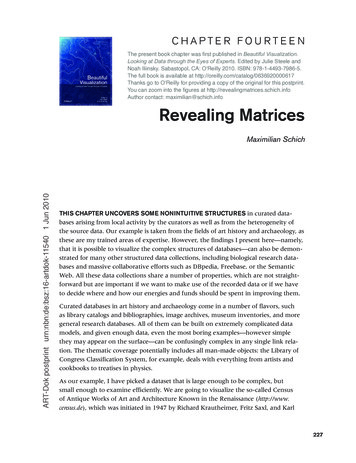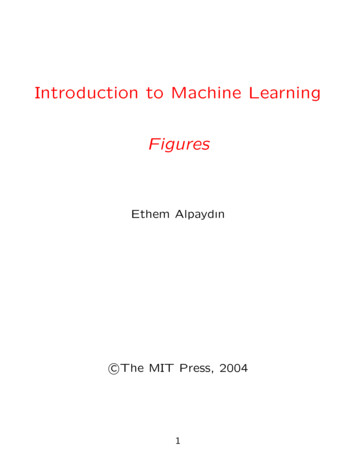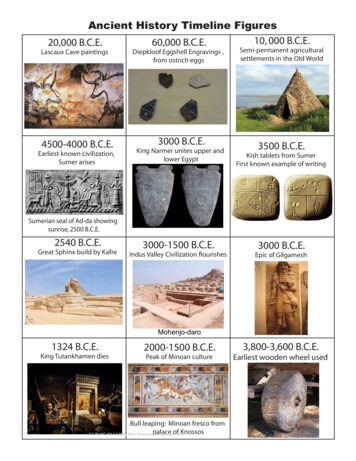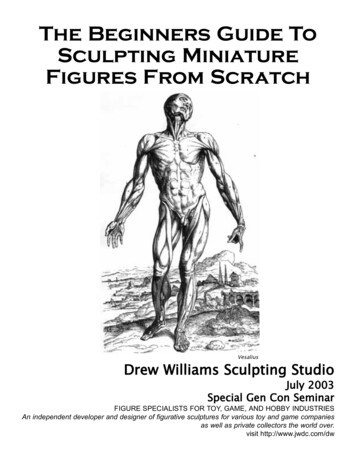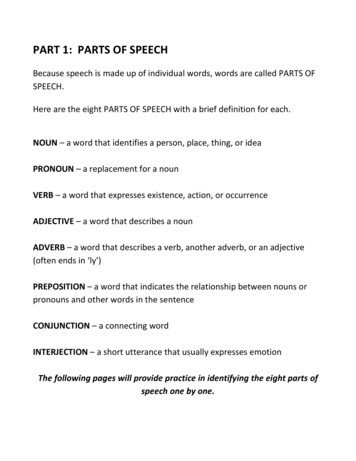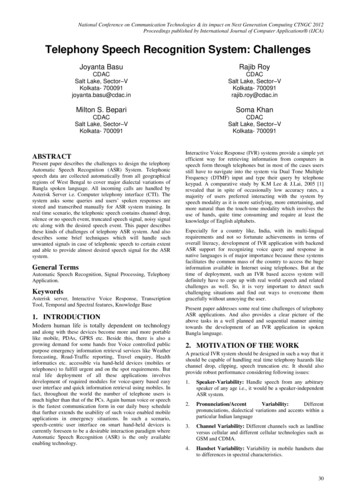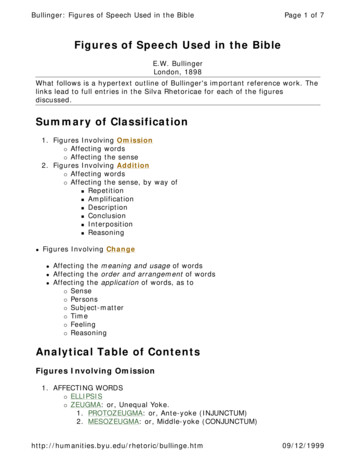
Transcription
Bullinger: Figures of Speech Used in the BiblePage 1 of 7Figures of Speech Used in the BibleE.W. BullingerLondon, 1898What follows is a hypertext outline of Bullinger's important reference work. Thelinks lead to full entries in the Silva Rhetoricae for each of the figuresdiscussed.Summary of Classification1. Figures Involving Omission¡ Affecting words¡ Affecting the sense2. Figures Involving Addition¡ Affecting words¡ Affecting the sense, by way ofn Repetitionn Amplificationn Descriptionn Conclusionn Interpositionn ReasoninglFigures Involving ChangelllAffecting the meaning and usage of wordsAffecting the order and arrangement of wordsAffecting the application of words, as to¡ Sense¡ Persons¡ Subject-matter¡ Time¡ Feeling¡ ReasoningAnalytical Table of ContentsFigures Involving Omission1. AFFECTING WORDS¡ ELLIPSIS¡ ZEUGMA: or, Unequal Yoke.1. PROTOZEUGMA: or, Ante-yoke (INJUNCTUM)2. MESOZEUGMA: or, Middle-yoke linge.htm09/12/1999
Bullinger: Figures of Speech Used in the BiblePage 2 of 73. HYPOZEUGMA: or, End-yoke4. SYNEZEUGMENON: or, Connected-yoke (ADJUNCTUM)¡ ASYNDETON: or, No-Ands.¡ APHAERESIS: or, Front-Cut.¡ APOCOPE: or, End-Cut.2. AFFECTING THE SENSE.¡ APOSIOPESIS: or, Sudden Silence¡ MEIOSIS: or, a Be-littleing.¡ TAPEINOSIS: or, Demeaning.¡ CATABASIS¡ SYLLOGISMUS: or, Omission of the Conclusion¡ ENTHYMEMA: or, Omission of the PremissFigures Involving Addition1. Affecting Words1. Repetition of Letters and Syllablesn HOMOEOPROPHERON: or Alliteration.n HOMOEOTELEUTON: or, Like Endings.n HOMOEOPTOTON: or, Like Inflections.n PAROMOEOSIS: or, Like-Sounding Inflections.n ACROSTICHION: or, Acrostic.2. The Repetition of the Same Wordn EPIZEUXIS: or, Duplication.n ANAPHORA: or, Like-Sentence Beginnings.n EPANALEPSIS: or, Resumption.n POLYSYNDETON: or, Many-Ands.n PARADIASTOLE: Neithers and Nors.n EPISTROPHE: or, Like Sentence-Endings.n EPIPHOZA: or, Epistrophe in Argumentn EPANADIPLOSIS: or, Encircling.n EPADIPLOSIS: or, Repeated Epanadiplosisn ANADIPLOSIS: or, Like Sentence-Endings and Beginnings.n CLIMAX: or, Gradation.n MESARCHIA: or, Beginning and Middle Repetition.n MESODIPLOSIS: or, Middle Repetition.n MESOTELEUTON: or, Middle and End Repetition.n REPETITIO: or, Repetition.n POLYPTOTON: or, Many Inflections.n ANTANACLASIS: or, Word-Clashing, andn PLOCE: or, Word-Folding.n SYNOECEIOSIS: or, Cohabitation.n SYLLEPSIS: or, Combination.3. The Repetition of Different Words1. In a similar order (but same sense).n SYMPLOCE: or, Intertwining.2. In a different order (but same .htm09/12/1999
Bullinger: Figures of Speech Used in the BiblePage 3 of 7EPANADOS: or, Inversion.n ANTIMETABOLE: or Counter-change.3. Similar in sound, but different in sense.n PAREGMENON: or, Derivation.n PARANOMASIA: or Rhyming-Words.n PARACHESIS: or, Foreign Paronomasia.4. Different in sound, but similar in sensen SYNONYMIA: or, Synonymous Words.n REPEATED NEGATION: or, Many Noes.4. The Repetition of Sentences and Phrasesn CYCLOIDES: or, Circular Repetition.n AMOEBAEON: or, Refrain.n COENOTES: or, Combines Repetition.n EPIBOLE: or, Overlaid Repetition.n SYNANTESIS: or, Introverted Repetition.5. The Repetition of Subjectsn PARALELLISM: or, Parallel Lines.n CORRESPONDENCE.2. AFFECTING THE SENSE (Figures of Rhetoric)1. REPETITIOn PROSAPODOSIS: or, Detailing.n EPIDIEGESIS: or, Re-Statement.n EPEXEGESIS: or, Fuller Explaining.n EXERGASIA: or, Working-Out.n EPIMONE: or, Lingering,n HERMENEIA: or, Interpretation.n BATTALOGIA: or, Vain Repetition.2. AMPLIFICATIOn PLEONASM: or, Redundancy.n PERIPHRASIS: or, Circulocution.n HYPERBOLE: or, Exaggeration.n ANABASIS: or, Gradual Ascentn CATABASIS: or, Gradual Descent.n MERISMOS: or, Distribution.n SYNATHOESMOS: or, Enumeration.n EPITROCHASMOS: or, Summarising.n DIEXODOS: or, Expansion.n EPITHETON: or, Epithet.n SYNTHETON: or, Combination.n HORISMOS: or, Definition.3. DESCRIPTIOn HYPOTYPOSIS: or, Word-Picture.n PROSOPOGRAPHIA: or, Description of Personsn EFFICTIO: or, Word-Portraitn CHARACTERISMOS: or, Description of Charactern ETHOPOEIA: or, Description of Mannersn PATHOPOEIA: or, Description of ge.htm09/12/1999
Bullinger: Figures of Speech Used in the BiblePage 4 of 7MIMESIS: or, Description of Sayingsn PRAGMATOGRAPHIA: or, Description of Actionsn CHRONOGRAPHIA: or, Description of Timen PERISTASIS: or, Description of Circumstancesn PROTIMESIS: or, Description of Order4. CONCLUSIOn EPICRISIS: or, Judgment.n EPITASIS: or, Amplification.n ANESIS: or, Abating.n EPIPHONEMA: or, Exclamation.n PROECTHESIS: or, Justification.n EPITHERAPEIA: or, Qualification.n EXEMPLUM: or, Example.n SYMPERASMA: or, Concluding Summary.5. INTERPOSITIOn PARENTHESIS: Parenthesis.n EPITRECHON: or, Running Along.n CATAPLOCE: or, Sudden Exclamation.n PAREMBOLE: or, Insertion.n INTERJECTIO: or, Interjection.n EJACULATIO: or, Ejaculation.n HYPOTIMESIS: or, Under-Estimating.n ANAERESIS: or, Detraction.6. RATIOCINATIOn PARADIEGESIS: or, A Bye-Leading.n SUSTENTATIO: or, Suspense.n PARALEIPSIS: or, A Passing-By.n PROSLEPSIS: or, Assumption.n APOPHASIS: or, Insinuation.n CATAPHASIS: or, Affirmation.n ASTEISMOS: or, Politeness.nFigures Involving Change1. AFFECTING THE MEANING OF WORDS¡ ENALLAGE: or, Exchange.¡ ANTEMEREIA: or, Exchange of Parts of Speech¡ ANTIPTOSIS: or, Exchange of Cases.¡ HETEROSIS: or, Exchange of Accident¡ HYPALLAGE: or, Interchange.¡ METONYMY: or, Change of Noun.¡ METALEPSIS: or, Double Metonymy.¡ SYNECDOCHE: or, Transfer.¡ HENDIADYS: or, Two for One.¡ HENDIATRIS: or, Three for One.¡ CATACHRESIS: or, Incongruity.¡ METALLAGE: or, A Changing tm09/12/1999
Bullinger: Figures of Speech Used in the BiblePage 5 of 7ANTONOMASIA: or, Name-Change.¡ EUPHEMISMIS: or, Euphemy.¡ APLIATIO: or, Adjournment¡ ANTIPHRASIS: or, Permutation2. AFFECTING THE ARRANGEMENT AND ORDER OF WORDS1. SEPARATE WORDSn HYPERBATON: or, Transposition.n ANASTROPHE: or, Arraignment.n SYLLEPSIS: or, Change in Concord.n TIMESIS: or, Mid-Cut.2. SENTENCES AND PHRASESn HYSTERON-PROTERON: or, The Last, First.n HYSTEROLOGIA: or, The First, Last.n HYSTERESIS: or, Subsequent Narration.n SIMULTANEUM: or, Insertion.n ANTITHESIS: or, Contrast.n ENANTIOSIS: or, Contraries.n ANACOLUTHON: or, Non-sequence.3. AFFECTING THE APPLICATION OF WORDS1. As to Sensen SIMILE: or, Resemblance.n SYNCRISIS: or, Repeated Simile.n METAPHOR: or, Representation.n HYPOCATASTASIS: or, Implication.n ALLEGORY: or, Continued Metaphor and Hypocatastasis.n PARABOLA: or, Parablen APOLOGUE: or, Fablen PAROEMIA: or, Proverb.n TYPE.n SYMBOL.n AENIGMA: or, Enigman POLYONYMIA: or, Many Names.n GNOME: or, Quotation.n CHREIAn NOEMAn ACCOMODATIOn AMPHIBIOLOGIA: or, Double Meaning.n EIRONEIA: or, Irony.n ANTIPHRASIS,n PERMUTATIOn SARCASMOSn OXYMORON: or, Wise-follyn IDIOMA: or, Idiom.2. AS TO PERSONSn PROSOPOPOEIA: or, Personification.n ANTIPROSOPOPOEIA: or, Anti-Personificationn ANTHROPOPATHEIA: or, bullinge.htm09/12/1999
Bullinger: Figures of Speech Used in the BiblePage 6 of 7ANTIMETATHESIS: or, Dialogue.n ASSOCIATION: or, Inclusion.n APOSTROPHE.n PARECBASIS: or, Digression.AS TO SUBJECT-MATTERn METABASIS: or, Transition.n EPANORTHOSIS: or, Correction.n AMPHIDIORTHOSIS: or, Double Correction.n ATACHORESIS: or, Regression.AS TO TIMEn PROLEPSIS (AMPLIATIO): or, Anticipation.AS TO FEELINGn PATHOPOEIA: or, Pathos.n ATEISMOS: or, Urbanity.n ANAMNESIS: or, Recalling.n BENEDICTIO: or, Blessing.n EUCHE: or, Prayer.n PARAENETICON, or, Ehortation.n OEONISMOS: or, Wishing.n THAUMASMOS: or, Wondering.n PAEANISMOS: or, Exultation.n ASTERISMOS: or, Indicating.n ECPHONESIS: or, Exclamation.n APORIA: or, Doubt.n EPITIMESIS: or, Reprimand.n ELEUTHERIA: or, Candour.n AGANACTESIS: or, Indignation.n APOSIOXIS: or, Detestation.n DEPRECATIO: or, Deprecation.n DIASYRMOS: or, Raillery.n CATAPLEXIS: or, Menace.n EXOUTHENISMOS: or, Contempt.n MALEDICTO: or, Imprecation.n DEASIS: or, Adjuration.n CHLEUASMOS: or, Mocking.AS TO ARGUMENTATIONn EROTESIS: or Interrogating.n DIALOGISMOS: or, Dialogue.n DIANOEA: or, an Animated Dialogue.n AFFIRMATIO: or, Affirmation.n NEGATIO: or, Negation.n ACCISMUS: Apparent Refusaln AETIOLOGIA: or, Cause Shown.n ANTEISAGOSE: or, Counter-Question.n ANISTROPHE: or Retort.n ANTICATEGORIA: or, Tu Quoque.n METASTASIS: or, hetoric/bullinge.htm09/12/1999
Bullinger: Figures of Speech Used in the BiblennnnnnnnPage 7 of 7ANACOENOSIS: or, Common Cause.SYNCHORESIS: or, Concession.EPITROPE: or, Admission.PAROMOLOGIA: or, Confession.PROTHERAPEIA: or, Conciliation.PRODIORTHOSIS: or, Warning.POLINODIA: or, Retracting.PROLEPSIS (OCCUPATIO): or, llinge.htm09/12/1999
ellipsisPage 1 of 1ellipsisel-lip'-sisfrom Gk. elleipein, "to come short"Also sp. elipsis, elleipsis, eclipsisdefectusfigure of defaultOmission of a word or short phrase easily understood in context.ExampleJohn forgives Mary and Mary, John.Note that the comma signals what has been elided, "forgives"Related FiguresllsyllepsisOther figures of omissionConnections to Other Parts of RhetoricllGeneral Rhetorical Strategy: SubtractionGeneral Rhetorical Strategy: OmissionSources: Quintilian 9.3.58, 8.6.21 ("eclipsis"); Susenbrotus (1540) 25 ("eclipsis"); Sherry (1550) 31 ("eclipsis," "defectus");Peacham (1577) E3v ("eclipsis"); Putt. (1589) 175 ("eclipsis," "figure of default"); Day 1599 81 ("eclipsis") 1996-98, Gideon O. Burton, Brigham Young UniversityPlease cite "Silva Rhetoricae" s SILVA RHETORICAE FlowersSearch the Forestfile://C:\Program Files\Teleport Pro\Projects\Bullinger .\ellipsis.ht09/12/1999
OmissionPage 1 of 1OmissionGeneral Rhetorical StrategiesAs a general strategy of rhetoric, omission occurs on many levels oflanguage. On a large scale, it is associated with the rhetorical exerciseknown as abbreviation. On a smaller scale, there are numerousrhetorical schemes (unusual arrangements of words or clauses) andrhetorical tropes (unusual uses of words) based on omission of one sortor another:Related Figures: Schemes Based on OmissionlllellipsisOmission of a word or words readily implied by context.asyndetonOmission of conjunctions between a series of clauses.brachylogiaOmission of conjunctions between a series of words.Related Figures: Tropes Based on OmissionllllapocopeThe omission of a letter or syllable at the end of a wordaphaeresisThe omission of a letter or syllable at the beginning of a word.syncopeCutting letters or syllables from the middle of a word.synaloephaOmitting one of two vowels which occur together at the end of one wordand the beginning of another.Connections to Other Parts of RhetoricllGeneral Rhetorical Strategy: AbbreviationGeneral Rhetorical Strategy: Subtraction 1996-98, Gideon O. Burton, Brigham Young UniversityPlease cite "Silva Rhetoricae" s SILVA RHETORICAE FlowersSearch the Forestfile://C:\Program Files\Teleport Pro\Projects\Bullinge.\omission.ht09/12/1999
asyndetonPage 1 of 1asyndetona-syn’-de-tonfrom a and sundeton “bound together with”Also sp. asindetonbrachiepiaarticulus, dissolutio, dissolutumloose languageThe omission of conjunctions between clauses, often resulting in ahurried rhythm or vehement effect.ExampleVeni, vidi, vinci (Caesar: "I came; I saw; I conquered")Related FiguresllllllOther grammatical onhirmusConnections to Other Parts of RhetoriclGeneral Rhetorical Strategy: OmissionSources: Ad Herennium 4.30.41; Quintilian 9.3.53-54 ("acervatio"); Isidore 1.36.20; Sherry (1550) 59 ("asindeton,""dissolutio"); Peacham (1577) G4r, I4r; Putt. (1589) 185 ("asyndeton," "the loose language"); Day 1599 83 1996-98, Gideon O. Burton, Brigham Young UniversityPlease cite "Silva Rhetoricae" s SILVA RHETORICAE FlowersSearch the Forestfile://C:\Program Files\Teleport Pro\Projects\Bullinge.\asyndeto.ht09/12/1999
apocopePage 1 of 1apocopea-poc’-o-pefrom Gk. apo “away from” and koptein “to cut”("a cutting off")abissio, abscissio, or absissiocutting from the endOmitting a letter or syllable at the end of a word. A kind ofmetaplasm.ExampleIn the following quotation, "often" has been shortened to "oft" byapocope :True art is nature to advantage dressedWhat oft was thought, but ne'er so well expressed--Alexander PopeIn the following quotation from Hamlet, "attentive" is shortened to"attent" via apocope:Season your admiration for awhile With an attent ear. --ShakespeareHamlet 1.2.192Related boleConnections to Other Parts of RhetoriclGeneral Rhetorical Strategy: OmissionSources: Isidore 1.35.3; Susenbrotus (1540) 21; Sherry (1550) 27 ("apocope," "absissio"); Wilson (1560) 200 ("cutting fromthe end");Peacham (1577) E2v 1996-98, Gideon O. Burton, Brigham Young UniversityPlease cite "Silva Rhetoricae" s SILVA RHETORICAE FlowersSearch the Forestfile://C:\Program Files\Teleport Pro\Projects\Bullinger.\apocope.ht09/12/1999
aphaeresisPage 1 of 1aphaeresisfrom Gk. apo “away” and hairein “to take”("a taking away from")Also sp. apheresisablatioabstraction from the firstaph-aer’-e-sisThe omission of a syllable or letter at the beginning of a word. Akind of metaplasm.ExamplesWhat's the third R? Rithmetic!In the following quotation, "complain" has been shortened to "plain"by aphaeresis:The King hath cause to plain. --Shakespeare, King Lear 3.1.39Related FiguresllmetaplasmapocopeThe omission of a syllable at the end of a word.Connections to Other Parts of RhetoriclOmissionSources: Isidore 1.35.3; Susenbrotus (1540) 20; Sherry (1550) 26 ("apheresis," "ablatio"); Wilson
What follows is a hypertext outline of Bullinger's important reference work. The The links lead to full entries in the Silva Rhetoricae for each of the figures

